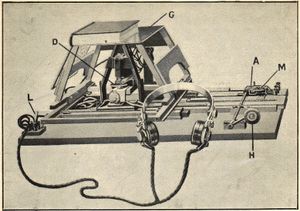The Optophone
Simulating the cutting-edge assistive technology of the 1910s, which aimed to open the world's literature to blind people.
Reading time: 2–4 minutes

When do you think the earliest text-to-sound devices appeared?
An early screen reader in the 1980s? The Kurzweil system in the 1970s? The first tinny synthetic voice in the 1930s?
There's actually an invention that pre-dates text-to-speech. A text-to-sound device; the optophone.
The optophone first appeared in 1913. It's described in some detail, with photographs, in a paper in Nature in 1920 (open access). Physicist Edmund Edward Fournier d'Albe, the inventor, explained how it worked.
The document sits face-down above a small slit, thorough which light shines into the paper. A system of lenses break the light into seven spots. If the document is black (printed on) on that spot, it absorbs the light, if not, the light reflects back in. The light hits some selenium, a light-sensitive component. Finally, a "telephone" converts the combination of input signals into a sound.
As the document moves along the slit, different letters make different sounds. A curved letter S produces "changing notes which are characteristic of the letter".
Let's try an example. I made this based on a public domain example. It's a simulation, rather than a recording of a real device. I'll use the word 'ink' to refer to the printed parts, depending on your preferred color scheme, this might be black or white.
This example concerns a black-sounding optophone. This is one which made higher pitched noises the more ink was present. A white-sounding optophone was invented first, but might be less intuitive to depict.
The word 'him' has three letters. As the slit moves in reading order across them, there are periods of silence, when there's no ink.
As the slit moves, more or less of the view contains ink. At the start of the h, the slit is full of ink, so the frequency is high. Over the 'bridge', there's only a tiny bit of ink visible, so a lower frequency plays. Finally, in the vertical part, about half of the slit will be ink, and the tone is somewhere in the middle.
This way, every letter has a distinct sound. The same letter in different type faces will have different, similar sounds.
Users need to learn a new, audible representation for their alphabet. This representation relates to the shape of the characters, but it's possibe to memorize sounds without knowing the shapes.
Like any type of reading, this is a skill that would improve with practice. A note by test user Mary Jameson, written in 1966, tells of her own experiences. She says that in 1918, she was able to manage a speed of "one word per minute" on the optophone. She also expresses some optimism about more recent developments in the technology. Fournier d'Albe stated in the Nature paper that by 1920, Jameson was reading at around 25 words per minute. He believed that with practice, reading a line could take "from five seconds to five minutes".
Back in 1920, Fournier d'Albe seemed confident in the invention, writing;
It is therefore safe to say that the problem of opening the world's literature to the blind is now definitely solved.
The technology has come a long way since then, though I'm sure some people say the problem is still not fully solved.
This isn't the earliest type of assistive technology, but in this era, it is a remarkable invention. It seems to have paved the way for the Kurzweil system and modern screen readers.